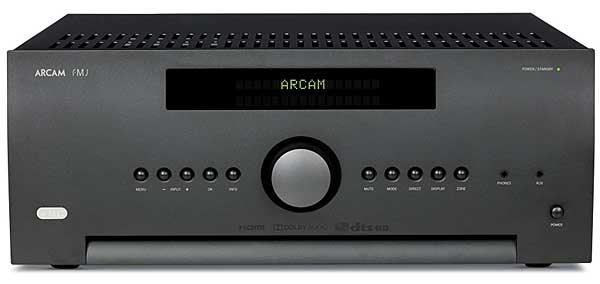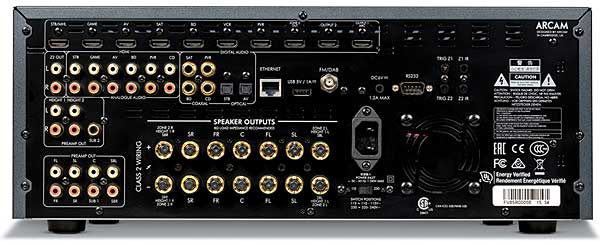OK.... Arcam in a single box or Marantz front end and Bryston power amps.?
Arcam AVR850 A/V Receiver Review

AT A GLANCE
Plus
Outstanding seven-channel power from uncommon amp topology
Dirac Live auto setup and room correction
Winning remote handset
Minus
Lacks wireless
connectivity
Premium pricing
THE VERDICT
Reference-grade seven-channel power, an unusual (and unusually effective) auto-EQ system, and refreshing simplicity and straightforward ergonomics in a pricey, albeit very attractive and well-executed package.
Arcam’s new flagship A/V receiver, the AVR850, is about the most expensive receiver you can buy today: $6,000 here in the Land of the Free(-ish) (not counting a slightly more expensive, similarly spec’d model sourced by Arcam for AudioControl). That’s a lot of simoleons for a box that, on the surface anyway, doesn’t do quite as much stuff as the big-brand models, doesn’t have as much claimed-on-paper power or as many colored lights or flashing displays, and which exudes a substantially simpler design aesthetic. So what do you get for your extra couple of kilo-clams?
Sound quality, that’s what. At least, that’s what the British firm claims—and the aggregate opinion of the audiophile world seems to concur. Whether you regard audio’s higher end as a tight-knit community or a mere rag-tag of warring tribes, it is most certainly a village, especially in today’s net-connected age, and the collective judgment of a village is rarely wrong. But rather than take it on faith, we solicited a sample of Arcam’s latest design.
The new model’s big stories are three. First, and in common with just about every other current top-line AVR: Dolby Atmos and DTS:X. Next, and in common with very few other receivers ever, as far as I know: an unusual amplifier topology, Class G. Geek-hats on, please: Class G is a version of an amplifying topology that has been around for decades. Instead of the high-voltage power rails (plus/minus DC voltages provided as the current reservoir to the power-output devices) found in all Class A and A/B designs that are used in the vast majority of amps and receivers, Class G maintins much lower-voltage rails, but with highervoltage sources available for shortterm demands. Since music’s peak-to-average power demands are on the order of 10 to 1 or more, this should have zero performance penalty, with the benefits of being smaller, cooler, and lighter. In Arcam’s implementation, the rail voltages are allowed to vary continuously (Class G), as opposed to hard-switching between two or more voltage levels (Class H, etc.).
And the third big story: Arcam’s design incorporates Dirac Live speaker setup and room-correction, a feature we’ve encountered before (in Emotiva’s XMC-1 pre/pro). Developed in Sweden, the Dirac solution requires outboard processing in the form of a PC or Mac during setup, but it provides a far more user-interactive experience than do consumer-level onboard systems such as Audyssey or the proprietary solutions found increasingly in mainstream AVRs. Dirac also claims that its mixed-phase filter algorithms are more effective in correcting time-domain errors (I’m paraphrasing here) than the finiteimpulse-response filters employed in most or possibly all other such systems. OK, you can remove the geek-hats now.
The Setup
The new Arcam looks very much like its predecessor, the AVR750, save for one important distinction: It has a knob on its front panel, whereas the AVR750 was an all-pushbutton affair. Progress! The design is quintessentially understated. The slightly bulging front panel has a semi-matte black-with-gray-in-it finish, and other than a pair of tiny 1/8-inch ports for headphone-out and aux-in, Arcam decided to forgo the usual frontpanel connection jacks. (Does anybody ever actually use those?) The result is one of the best-looking AVRs out there; I liked it extremely.

Around back, Arcam has followed Thoreau’s maxim to “simplify, simplify, simplify”: There are no analog video connections whatsoever, just a row of seven HDMI inputs (and three outs, including a second-zone option) and the corresponding stereo analog inputs. There’s a preamp output for 7.1.4 channels should you force Atmos maximus into play with the addition of outboard amps (but no multichannel analog inputs, which are increasingly unnecessary) and seven speaker outputs on substantial metal dual-banana pairs.
As implied above, the power-amp section is but a seven-channel affair, with numbers 6 and 7 assignable to front- or rear-height (or second-zone stereo), leaving, in a 5.1.4 setup such as mine, one Atmos height speaker pair powerless. However, the Arcam routes the unamplified height signal to a preamp-out pair, which I sent to two channels of my everyday power amp, sitting otherwise idle. (In practice, you could use almost any available two-channel amp or receiver.) Otherwise, setup was a mere matter of plugging things together: I ran the Arcam with my usual 5.1 suite, which includes moderately low-sensitivity, current-hungry main-front speakers, supplemented by a quad of PSB’s excellent Imagine XA elevation modules for Dolby Atmos or DTS:X. Nine channels is a lotta cables. Thank God mine are all banana-plugged, saving me from fumbling around with 18 bare wires.
Running the Dirac roomcorrection routine requires first downloading a free, de-featured version of Dirac Live from Arcam’s website. Then you proceed along mostly familiar lines (except that the provided setup mic is connected to the computer, not the receiver), following onscreen (TV, not computer) prompts to move the mic through six positions, pausing each time for channel-circulating sweeps and number-crunching. Twenty minutes or so later, Dirac displays gorgeous onscreen (computer, not TV) graphics of each channel’s response (or all of them) before and after, in either time- or frequency-domain plots.
- Log in or register to post comments


Definitely the latter.




































































